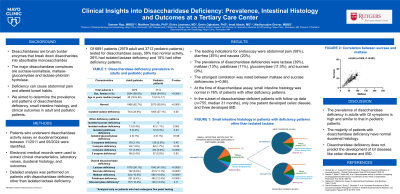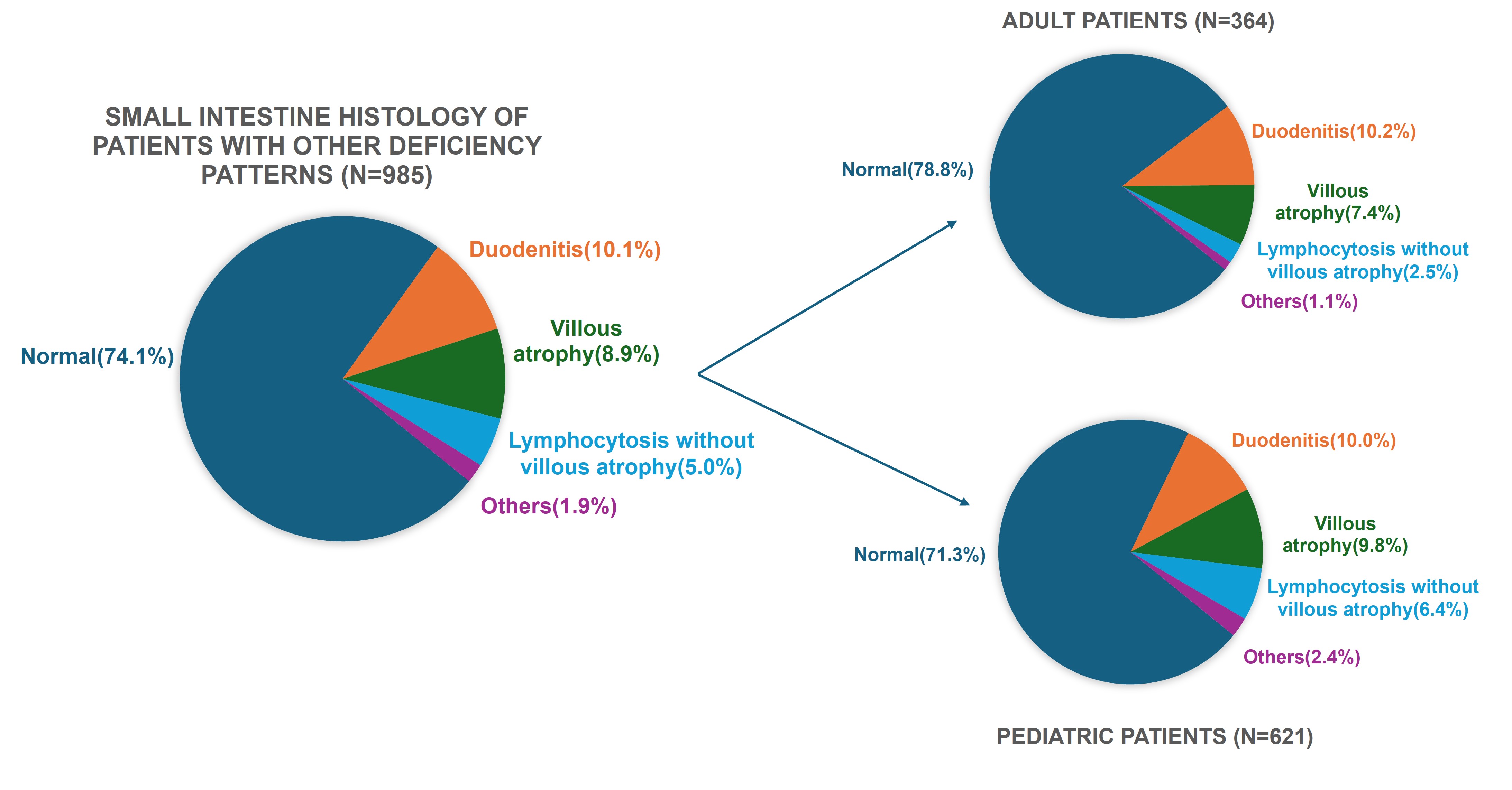Monday Poster Session
Category: Functional Bowel Disease
P2329 - Clinical Insights Into Disaccharidase Deficiency: Prevalence, Intestinal Histology, and Outcomes at a Tertiary Care Center
Monday, October 28, 2024
10:30 AM - 4:00 PM ET
Location: Exhibit Hall E

Has Audio
.jpg)
Sameer Rao, MBBS
Mayo Clinic
Newark, NJ
Presenting Author(s)
Sameer Rao, MBBS, Matthew Schultz, PhD, Elvira Lesmana, MD, Devin Oglesbee, PhD, Imad Absah, MD, Madhusudan Grover, MBBS
Mayo Clinic, Rochester, MN
Introduction: Disaccharidases are brush border enzymes that break down disaccharides into absorbable monosaccharides. Deficiency can cause abdominal pain and altered bowel habits. We aimed to determine the prevalence and patterns of disaccharidase deficiency, small intestine histology, and clinical outcomes.
Methods: Patients who underwent disaccharidase activity assay on duodenal biopsy samples between 11/2011 and 05/2024 were retrospectively identified. These assays were either performed at an external laboratory or Mayo Clinic laboratories. An electronic medical record review was conducted to extract clinical characteristics, laboratory values, small intestine histology and outcomes.
Results: Of 6691 patients (2979 adults, 3712 pediatrics) tested for disaccharidase assay, 3938 (59%) had normal activity, 1748 (26%) had isolated lactase deficiency and 1005 (15%) had other deficiency patterns. Among these patients, 420 (6%) had celiac disease and 434 (6%) had inflammatory bowel disease (IBD) at the time of testing. In celiac disease patients, 46% had normal activity, 25% had isolated lactase deficiency and 29% had other deficiency patterns, while in patients with IBD, 53% had normal activity, 27% had isolated lactase deficiency and 20% had other deficiency patterns. The most common indications for endoscopy at the time of assay were abdominal pain (58%), diarrhea (35%) and nausea (20%). The prevalence of disaccharidase deficiencies were lactase (39.1%), sucrase (9.0%), maltase (13.5%), palatinase (10.7%) and glucoamylase (11.0%). Pan-disaccharidase deficiency (deficiency of 4 or 5 enzymes in 4- or 5-panel testing, respectively) was observed in 8% of patients. The strongest correlation was noted between maltase and sucrase deficiencies (correlation coefficient=0.86). Lactase showed poor correlation with the others. At the time of disaccharidase assay, small intestine histology was normal in 76% of patients with other deficiency patterns and abnormal in 24% (figure 1). On follow-up in a subset of patients with disaccharidase deficiency (n= 755, median follow-up of 31 months), only 1 patient developed celiac disease, and 3 developed IBD.
Discussion: Disaccharidase deficiency is common in patients undergoing upper endoscopy for GI symptoms. Nearly 75% deficient patient has normal small intestinal histology. On follow-up, deficiency does not predispose to development of GI diseases like celiac disease and IBD.

Note: The table for this abstract can be viewed in the ePoster Gallery section of the ACG 2024 ePoster Site or in The American Journal of Gastroenterology's abstract supplement issue, both of which will be available starting October 27, 2024.
Disclosures:
Sameer Rao, MBBS, Matthew Schultz, PhD, Elvira Lesmana, MD, Devin Oglesbee, PhD, Imad Absah, MD, Madhusudan Grover, MBBS. P2329 - Clinical Insights Into Disaccharidase Deficiency: Prevalence, Intestinal Histology, and Outcomes at a Tertiary Care Center, ACG 2024 Annual Scientific Meeting Abstracts. Philadelphia, PA: American College of Gastroenterology.
Mayo Clinic, Rochester, MN
Introduction: Disaccharidases are brush border enzymes that break down disaccharides into absorbable monosaccharides. Deficiency can cause abdominal pain and altered bowel habits. We aimed to determine the prevalence and patterns of disaccharidase deficiency, small intestine histology, and clinical outcomes.
Methods: Patients who underwent disaccharidase activity assay on duodenal biopsy samples between 11/2011 and 05/2024 were retrospectively identified. These assays were either performed at an external laboratory or Mayo Clinic laboratories. An electronic medical record review was conducted to extract clinical characteristics, laboratory values, small intestine histology and outcomes.
Results: Of 6691 patients (2979 adults, 3712 pediatrics) tested for disaccharidase assay, 3938 (59%) had normal activity, 1748 (26%) had isolated lactase deficiency and 1005 (15%) had other deficiency patterns. Among these patients, 420 (6%) had celiac disease and 434 (6%) had inflammatory bowel disease (IBD) at the time of testing. In celiac disease patients, 46% had normal activity, 25% had isolated lactase deficiency and 29% had other deficiency patterns, while in patients with IBD, 53% had normal activity, 27% had isolated lactase deficiency and 20% had other deficiency patterns. The most common indications for endoscopy at the time of assay were abdominal pain (58%), diarrhea (35%) and nausea (20%). The prevalence of disaccharidase deficiencies were lactase (39.1%), sucrase (9.0%), maltase (13.5%), palatinase (10.7%) and glucoamylase (11.0%). Pan-disaccharidase deficiency (deficiency of 4 or 5 enzymes in 4- or 5-panel testing, respectively) was observed in 8% of patients. The strongest correlation was noted between maltase and sucrase deficiencies (correlation coefficient=0.86). Lactase showed poor correlation with the others. At the time of disaccharidase assay, small intestine histology was normal in 76% of patients with other deficiency patterns and abnormal in 24% (figure 1). On follow-up in a subset of patients with disaccharidase deficiency (n= 755, median follow-up of 31 months), only 1 patient developed celiac disease, and 3 developed IBD.
Discussion: Disaccharidase deficiency is common in patients undergoing upper endoscopy for GI symptoms. Nearly 75% deficient patient has normal small intestinal histology. On follow-up, deficiency does not predispose to development of GI diseases like celiac disease and IBD.

Figure: Small intestinal histology of patients with other deficiency patterns.
Note: The table for this abstract can be viewed in the ePoster Gallery section of the ACG 2024 ePoster Site or in The American Journal of Gastroenterology's abstract supplement issue, both of which will be available starting October 27, 2024.
Disclosures:
Sameer Rao indicated no relevant financial relationships.
Matthew Schultz indicated no relevant financial relationships.
Elvira Lesmana indicated no relevant financial relationships.
Devin Oglesbee indicated no relevant financial relationships.
Imad Absah indicated no relevant financial relationships.
Madhusudan Grover: Alfasigma – Advisory Committee/Board Member, Grant/Research Support. Ardelyx – Advisory Committee/Board Member. Evoke – Advisory Committee/Board Member. Takeda – Grant/Research Support.
Sameer Rao, MBBS, Matthew Schultz, PhD, Elvira Lesmana, MD, Devin Oglesbee, PhD, Imad Absah, MD, Madhusudan Grover, MBBS. P2329 - Clinical Insights Into Disaccharidase Deficiency: Prevalence, Intestinal Histology, and Outcomes at a Tertiary Care Center, ACG 2024 Annual Scientific Meeting Abstracts. Philadelphia, PA: American College of Gastroenterology.
